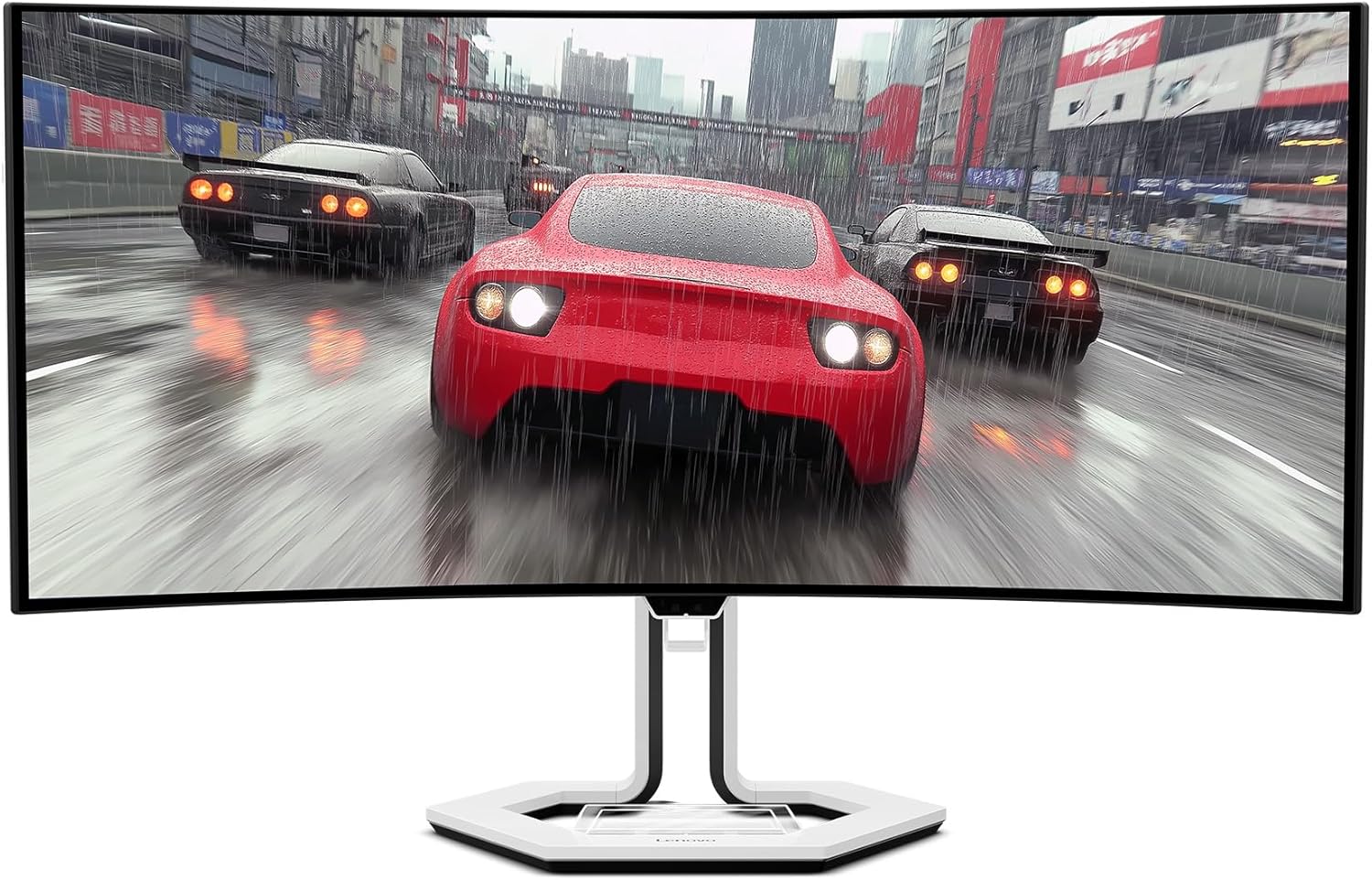
The Lenovo Legion Pro 34WD-10 is a stunning new addition to the OLED gaming display market. It features a 240Hz 3440 x 1440 output, making it suitable for all types of games and entertainment. It’s pricier than its closest competitors like the Alienware AW3425DW at launch, so let’s see how it compares.
Lenovo Legion Pro 34WD-10 Specifications
- Screen Size: 34 Inches
- Resolution: 3840 x 2160 UHD
- Aspect Ratio: 16:9
- Panel Technology: QD-OLED
- Refresh Rate: 240Hz
- Response Time: 0.03ms
- Contrast Ratio: 1500000:1
- Brightness: 275 cd/m2 (1300 cd/m2 (HDR Peak)
- Built-in Speakers: Yes (2 x 5 Watts)
- Stand: Height – Yes
- Stand: Tilt – Yes
- Stand: Swivel – Yes
- Stand: Pivot– None
- VESA Compatibility: Yes (100 x 100)
- Connectivity: DisplayPort 1.4 HBR3 x 1, HDMI 2.1 x 2, USB-C PD140W x 1, USB-C PD15W x 2, USB 3.2 x 4, RJ45 x 1
- Dimensions With Stand (WxHxD): 31.09″ x 17.42″ x 10.35″
- Weight: 19.18 lbs
Design and Features
The Lenovo Legion Pro 34WD-10’s design is more aggressive this time, but it still looks clean and sophisticated. The monitor has a matte white chassis with a glossy black grill at the back and bottom, reminding us of a sports or luxury car front end instead of a gaming monitor. The screen doesn’t have bezels, but it still has inner borders like any regular monitor.
Another noticeable aesthetic feature on this model is its RGB lighting at the bottom of the chassis. It can be controlled with Lenovo Artery or set to sync with the colors on the screen. It’s a nice touch indeed, but it can be distracting at night since the glow is quite bright and visible.
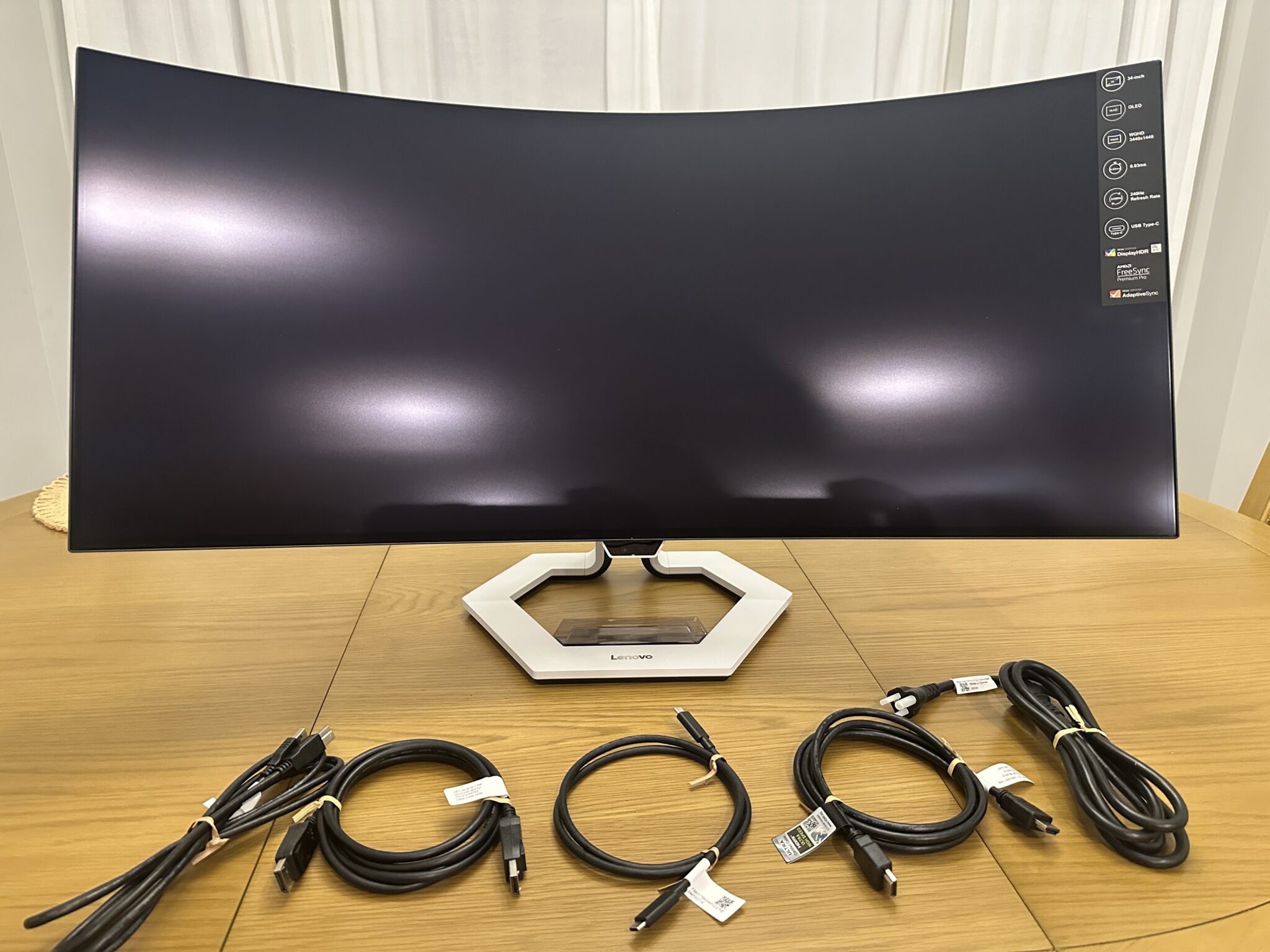
The product is boxed neatly to make it easier to take the device out without damaging it. However, we struggled with assembly for a bit because of how the base was designed and how it is secured to the upright. You will need four screws to assemble it, but what made it difficult was the asymmetric placement of locking pegs on the base.
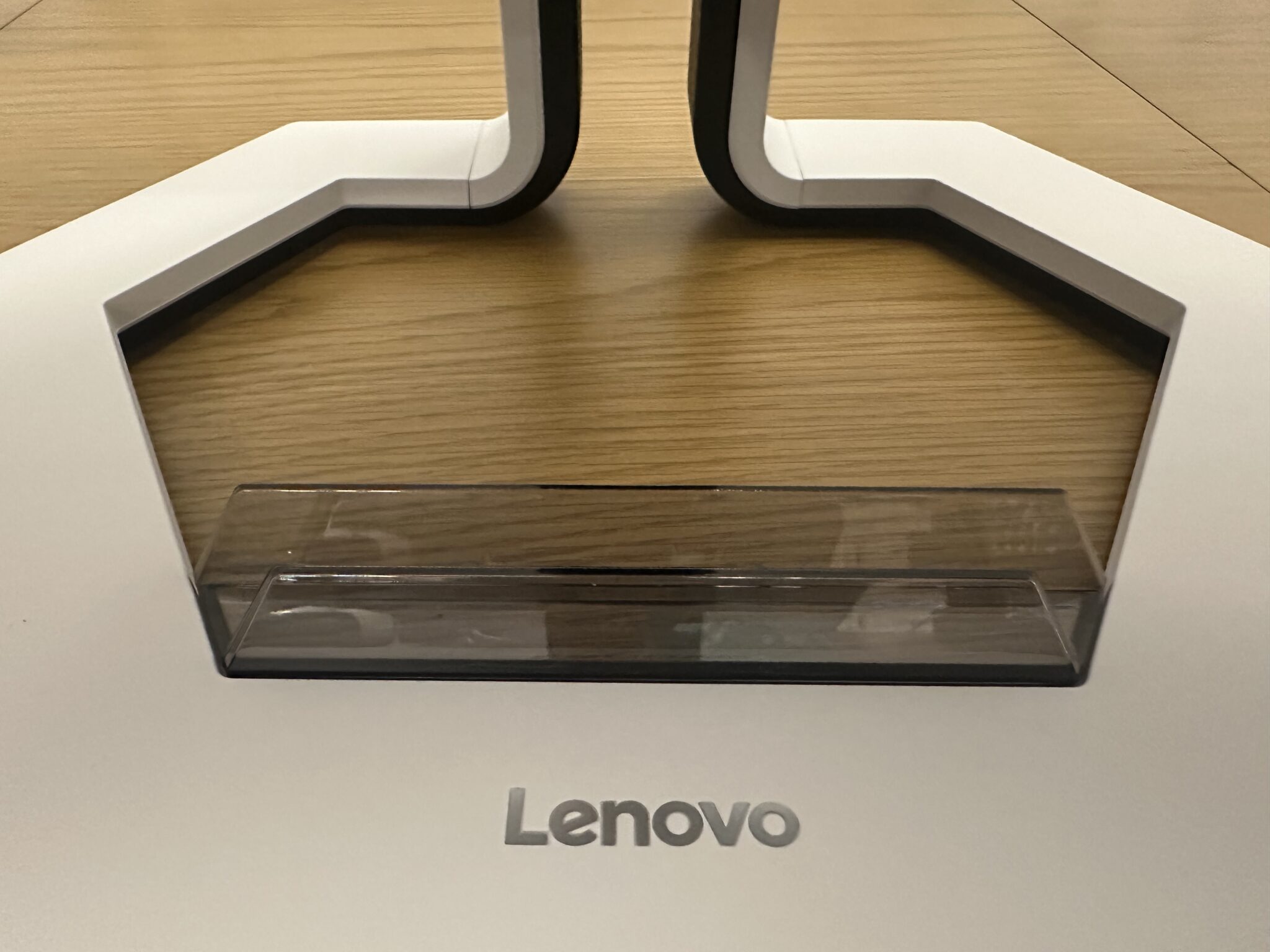
However, it’s a pretty strong design once fully assembled, despite our skepticism about whether it would hold or not. The screen can still wobble, but it’s surprisingly not that bad unless you hit the screen hard. The design takes up more space than other models, but that’s okay since the base is hollow in the middle and it has a phone holder to boot.
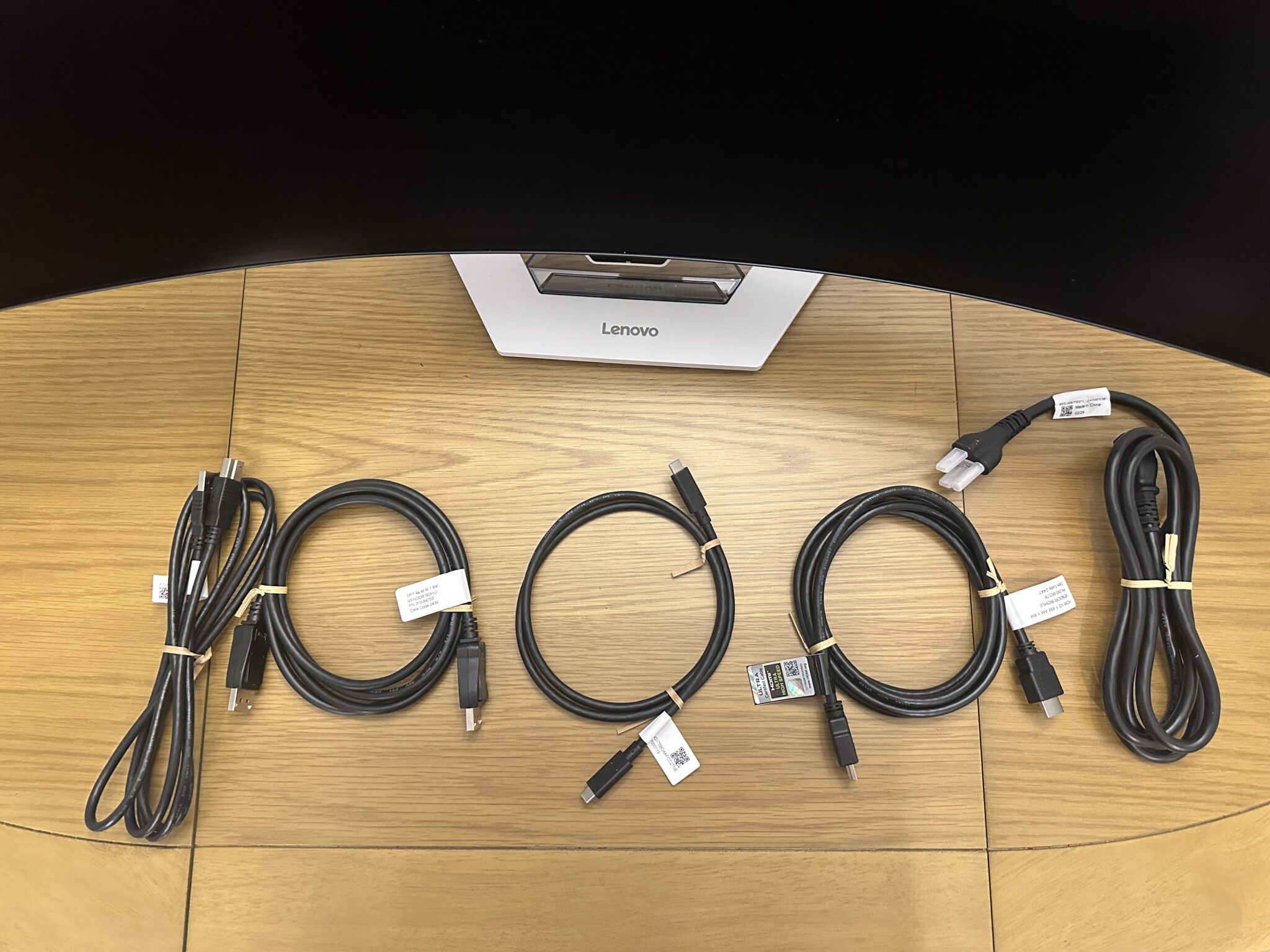
You also get everything you will need for the Lenovo Legion Pro 34WD-10’s functions with the package. You get cables for DP, HDMI, USB-C to USB-C, and a USB-B to USB-A wire for data upstream. You will also find documentation, including a calibration report for the device inside.
The Lenovo Legion Pro 34WD-10’s build quality is excellent and comparable with the brand’s other flagship offerings. The plastics used are thick and sturdy, and there were no signs of weakness or poor manufacturing processes. It’s hefty and solid, so it shouldn’t wobble or sag on you while you’re in the middle of an intense session.
Another thing we like about the Lenovo Legion Pro 34WD-10 is its OSD joystick that’s flanked by hotkeys and a dedicated power button. It’s very easy to control the monitor’s features with it, so calibration shouldn’t be too hard. You can also use the Lenovo Artery app for some features like the crosshair overlays, so it’s very convenient.
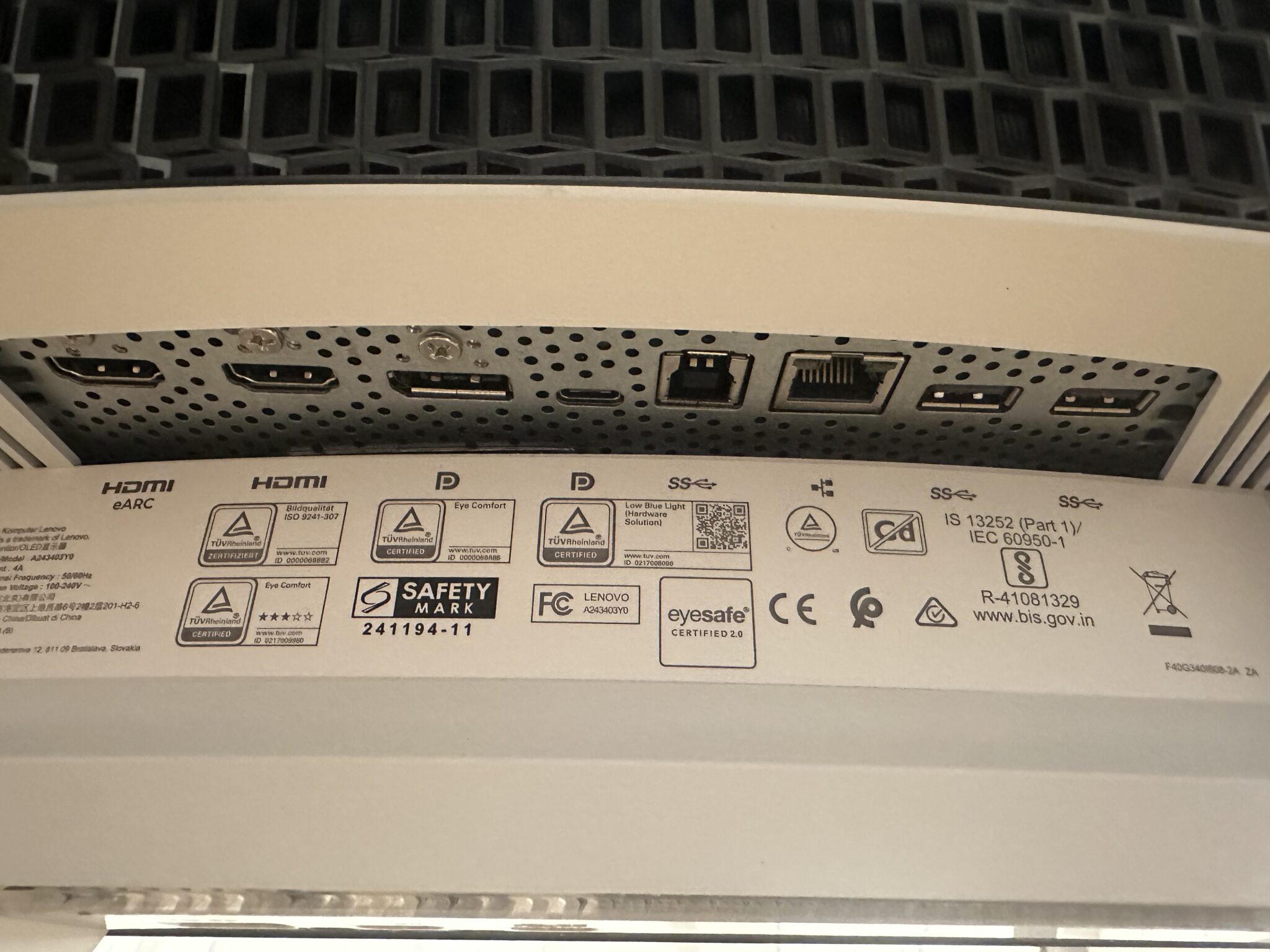
The monitor’s connectivity layout includes way more than what the Alienware AW3425DW offers. You get DisplayPort 1.4 and two HDMI 2.1 slots, along with a 140-watt USB-C port with DP Alt Mode that can handle most gaming laptops. You also get a slew of USB ports, including more Type-C slots, along with an RJ45 port with a wake-up via LAN feature.
These make the Lenovo Legion Pro 34WD-10 a capable platform for a multitude of devices, which are increasingly becoming common. DP and HDMI slots take gaming systems, while the USB-C slot can handle a productivity device like a MacBook Pro. This monitor is very flexible, so investing your money in it can be practical and beneficial.
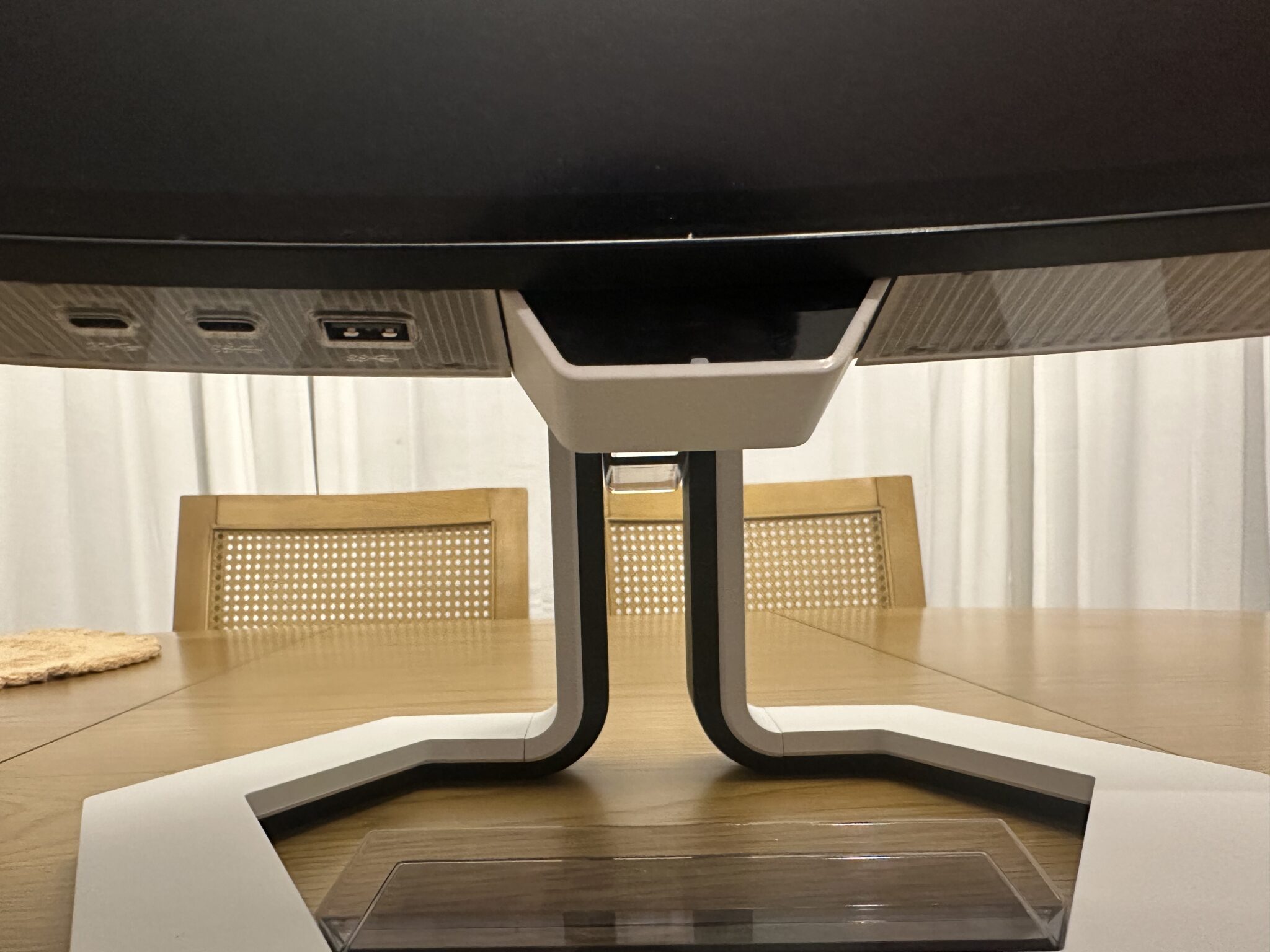
The sensor sticking from under the bottom bezel has a dual purpose. The monitor’s auto brightness adjustment feature uses it to manipulate the panel and match it with your ambient lighting. It also doubles as a sensor that checks if the user is present, so the system can rest the panel if there is no one in front of it.
The device is topped with a pair of 5-watt speakers with decent volume levels and clarity. They don’t pack a lot of bass and range, but that’s okay since it wasn’t meant for full-on performance anyway. Lenovo could have put together a better speaker package, but we’re okay with what’s included since headsets will be better anyway.
Display and Performance – Is the Lenovo Legion Pro 34WD-10 Worth It?
The Lenovo Legion Pro 34WD-10 boasts a 34-inch ultrawide OLED panel with a 3440 x 1440 resolution, a 240Hz max refresh rate, and a 0.03ms response time. Its brightness is listed at 275 cd/m2, but with a peak of 1300 cd/m2, along with a 1500000:1 contrast. This model is HDR 400 True Black rated, so it’s capable of substantially better HDR performance.
34-inch monitors aren’t rockstars anymore since there are bigger or wider variants out now. However, it’s still a great choice for most applications since it has extra room for more visuals or maneuvering your work while multitasking. You will need a more powerful GPU, but even some of the upper midrange cards will be able to handle this monitor.
The Lenovo Legion Pro 34WD-10 fired up without issue when we plugged it in, but it did not go straight to 240Hz. The display settings in our test PC did not show a 240 option initially, but its simply because DSC mode was necessary. Turning it on allowed us to get up to 240Hz without noticeable issues or penalties to the screen’s output.
The Lenovo Legion Pro 34WD-10 covered 100% sRGB and 94% of P3 for stunning color in games and movies. Its default accuracy isn’t so good since the deltaE average is quite high at 3.28. We didn’t notice any major issues, but meticulous users, especially those who do editing, will notice the color errors.
Calibrating it with our Calibrite Display Plus and the Profiler software improved the dE average to 1.1. That is not the best result we’ve seen, but it balances out the oversaturation in some instances. We don’t think it’s worth it for just gaming, but those who are into color-critical work might need it.
The Lenovo Legion Pro 34WD-10’s panel reached 365 cd/m2 in SDR, but it peaked at 1391 cd/m2 when HDR is active. Its contrast is incalculable, meaning it can provide true black depth or luminance, unlike IPS or VA panels. These characteristics are what make OLED the choice right now if visual quality is your top priority.
Panel uniformity for the test sample wasn’t great since there were variations on the sides and top edge of the screen. This isn’t as bad as it sounds on WLED panels, meaning it’s more difficult to notice the irregularities on an OLED display. Note that this can vary with every monitor made due to tolerances, so there are worse units out there.
Its pixel response time is fantastic, thanks to the natural advantage of OLED displays and the high refresh rate. Its lack of a backlight means the panel doesn’t have to wait on something for transitions, so there are no delays or persistence. It’s great for fast-paced games, especially if there’s a lot of high contrast transitions in them.
The Lenovo Legion Pro 34WD-10 is compatible with FreeSync and G-Sync, so tearing and stuttering won’t be a concern. VRR is necessary even if GPUs are more powerful, since FPS dips can still ruin your visual experience. Its input lag sits at 3ms at 240Hz, so it’s lightning fast like some of its competitors.
Thoughts on the Lenovo Legion Pro 34WD-10
The Lenovo Legion Pro 34WD-10 is a fantastic choice based on its design and capabilities. It has one of the brightest OLED panels we’ve encountered, and it’s also one of the best-looking models out there. The fast and vibrant screen is perfect for gaming and entertainment, but it’s also nice to have for productivity.
The first complaint most will have with the Lenovo Legion Pro 34WD-10 is its higher MSRP at launch. It also didn’t go sub 1.0 in color accuracy, but that’s a minor complaint in our eyes. It’s a fantastic buy overall, but we’d wait for the price to calm down a bit and match what other brands are asking.
Pros:
- Excellent Colors and Contrast
- High Brightness OLED
- Great Design and Features
- Useful Sensor Features
Cons:
- Expensive
- Not Prosumer Accurate
About the Author: 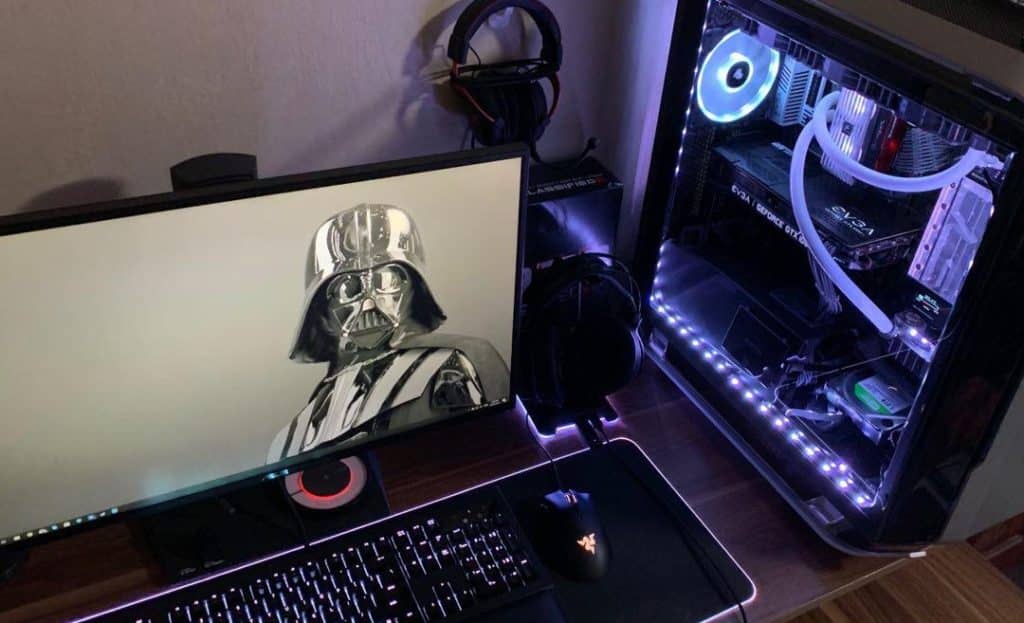
 Paolo is a gaming veteran since the golden days of Doom and Warcraft and has been building gaming systems for family, friends, and colleagues since junior high. High-performance monitors are one of his fixations and he believes that it’s every citizen’s right to enjoy one. He has gone through several pieces of hardware in pursuit of every bit of performance gain, much to the dismay of his wallet. He now works with Monitornerds to scrutinize the latest gear to create reviews that accentuate the seldom explained aspects of a PC monitor.</span
Paolo is a gaming veteran since the golden days of Doom and Warcraft and has been building gaming systems for family, friends, and colleagues since junior high. High-performance monitors are one of his fixations and he believes that it’s every citizen’s right to enjoy one. He has gone through several pieces of hardware in pursuit of every bit of performance gain, much to the dismay of his wallet. He now works with Monitornerds to scrutinize the latest gear to create reviews that accentuate the seldom explained aspects of a PC monitor.</span
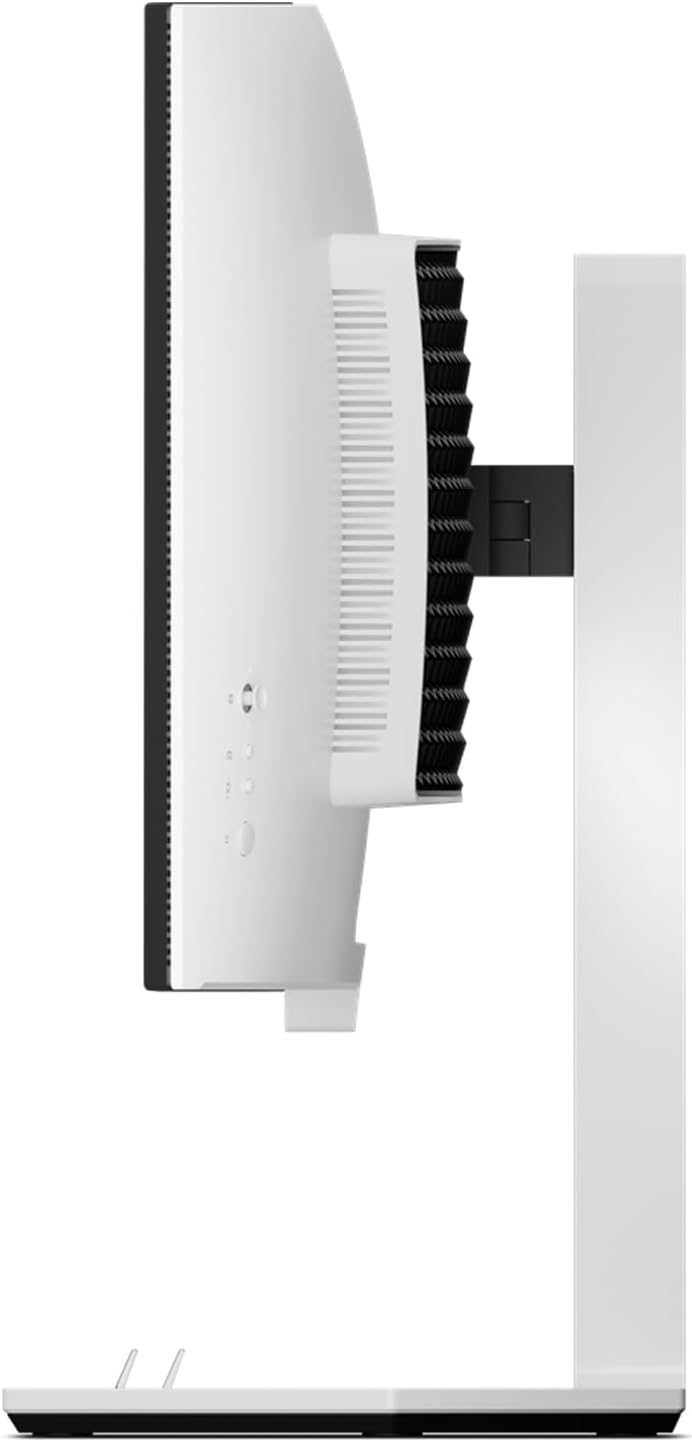
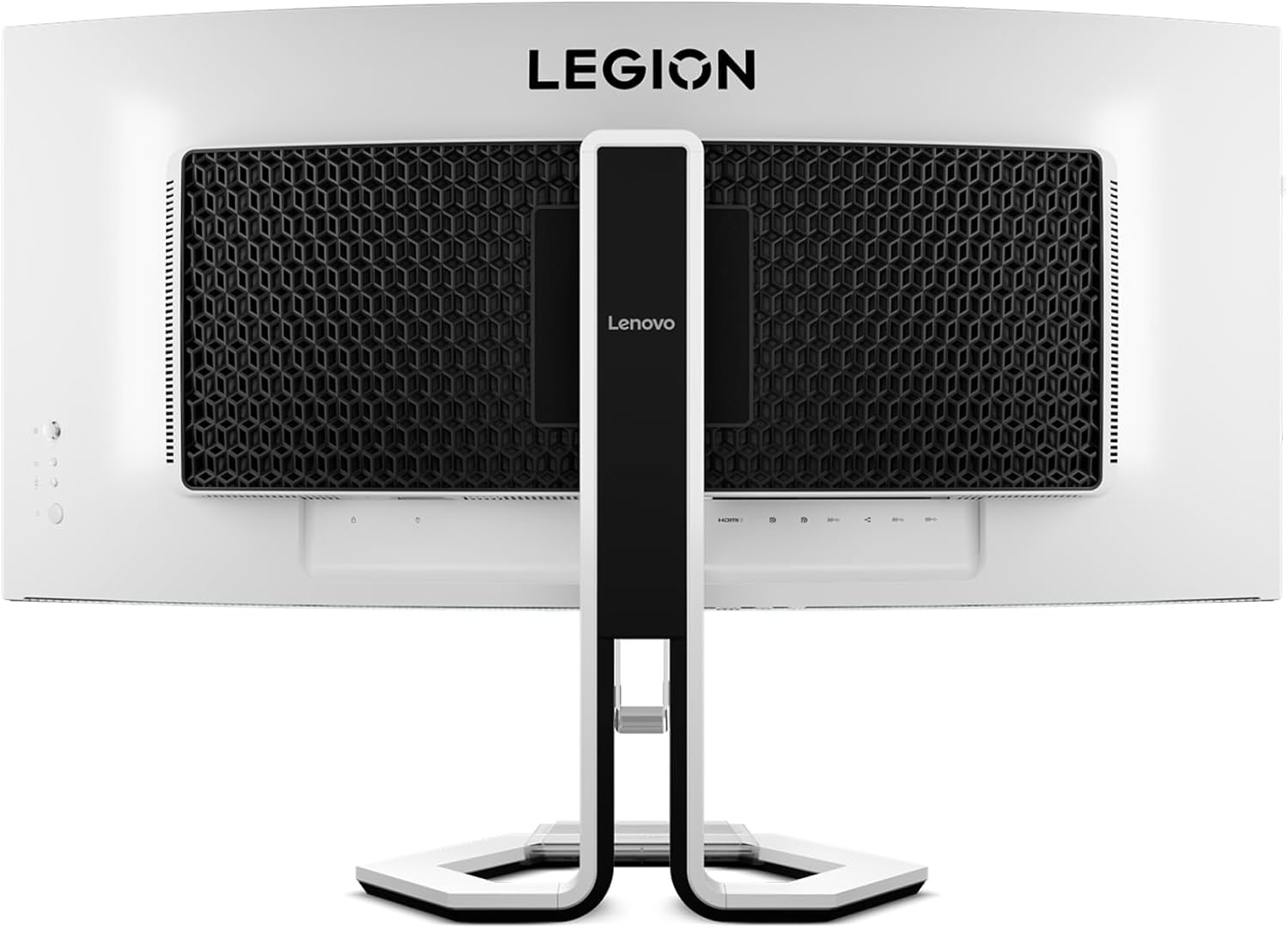
Leave a Reply